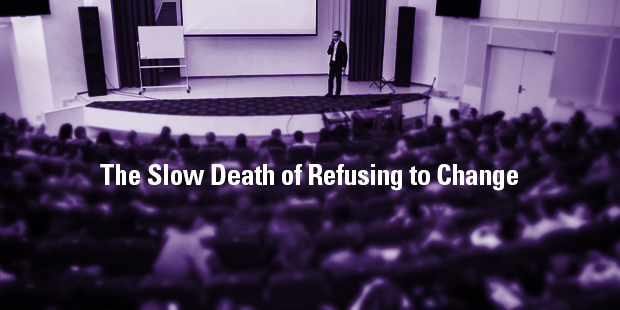
The Slow Death of Refusing to Change
It was a fascinating project.
Two Danish researchers traveled to 54 newsrooms in nine countries in search of desperately needed innovation in journalism. Their motivation was clear: “When citizens of Western societies, to a deeply disturbing extent, turn their backs on original news journalism, spend less time on news on radio or television, buy fewer newspapers, and express a growing distrust of media institutions, we need to submit the core content of the news media – journalism itself – to a critical review.”
They found that the crisis of journalism and legacy news media “is structural, and not just a matter of technological challenges or broken business models.” As a result, they found that the “news media most successful at creating and maintaining ties with their readers, users, listeners and viewers will increasingly be media that dare challenge some of the journalist dogmas of the last century.”
They walked away with nine core ideas, nine different ways (or movements) by which news media in the Western world are currently trying to “forge closer ties and stronger relations to their communities and audiences.” Here are the nine:
- From neutrality to identity. Let people know exactly what you stand for, who you are and from which perspective you view the world.
- From omnibus to niche. Create strong bonds with a very targeted audience. You can’t reach everyone, so don’t try.
- From flock to club. You aren’t after users or readers, but members who register or pay to join into a community.
- From ink to sweat. Quit thinking of journalism as simply a story you write or tell; create physical journalism in the form of public meetings, festivals, events and stage plays. Think “live and engaging.”
- From speaking to listening. Move from a “walled-up fortress” to an open and accessible house. Personal dialogue, physical presence… have the conversation be two-way.
- From arm’s length to cooperation. In the name of “independence” and “neutrality,” modern journalism has kept its distance from various citizens and interest groups, not to mention public institutions and private corporations. The move now is to involve citizens directly in everything from research to delivery. Even the subsequent debate of published stories.
- From own to other platforms. The old idea that it weakens business opportunities and journalistic control when content is released on social media is being replaced with the idea that at least cooperation with social media has the potential to enhance and deepen engagement and strengthen journalism itself.
- From problem to solution. Don’t just denounce or decry, or simply reveal and relay—add a solution-oriented dynamic to the work. “They read more, they are more likely to share content, and they express more interest in knowing more about the issue when the piece has a constructive angle.”
- From observers to activists. Taking a campaign-oriented approach to journalism, or advocacy mindset, creates relevance.
The researchers find no reason “to preach one particular model… for the future. All the experiments and ideas unfolding in the current media landscape… indicate that there will be dozens, if not hundreds, of different models, all of which carry a hope for the church in the future.”
The bottom line is that the church of the future will exist because of a focus on innovation and experiment. It will be founded on the courage and ambition of radical innovation. There will have to be a new understanding of the need for dramatic change and open-ended experiments. The message and intent is timeless and not to be changed, but the methods must be ruthlessly reevaluated.
Oops. Did I just write “church?” I meant “journalism.”
Or did I.













